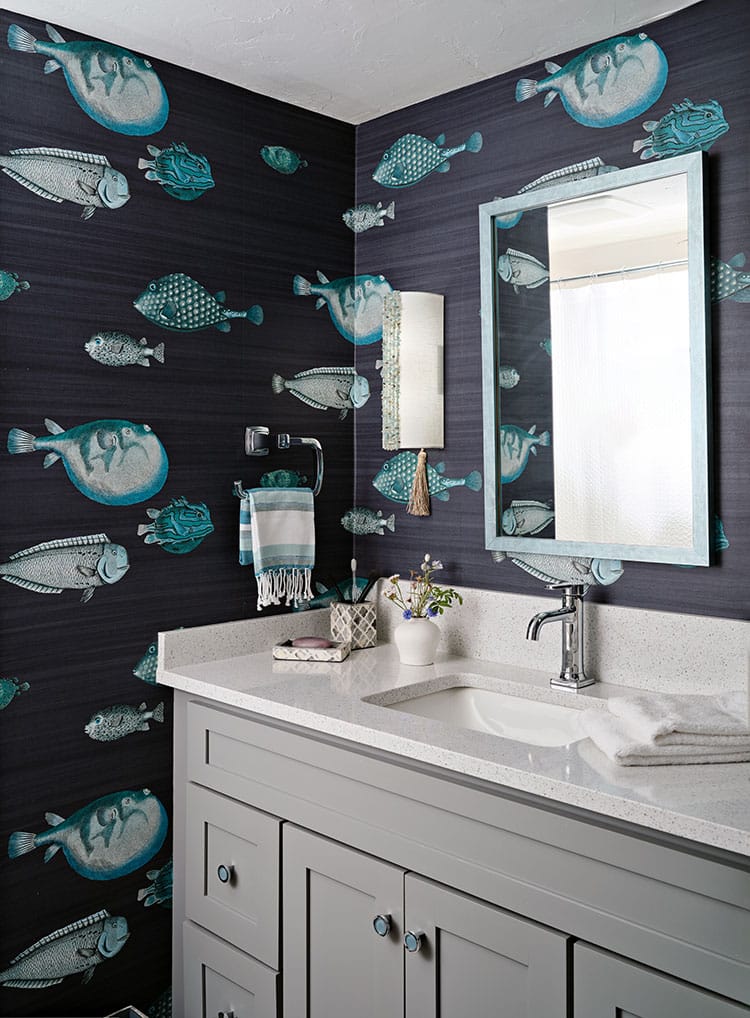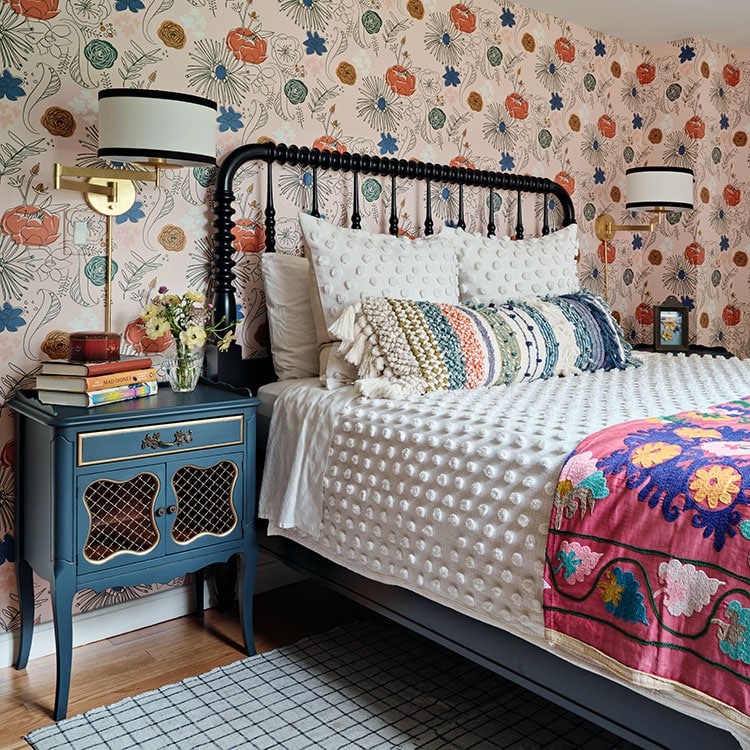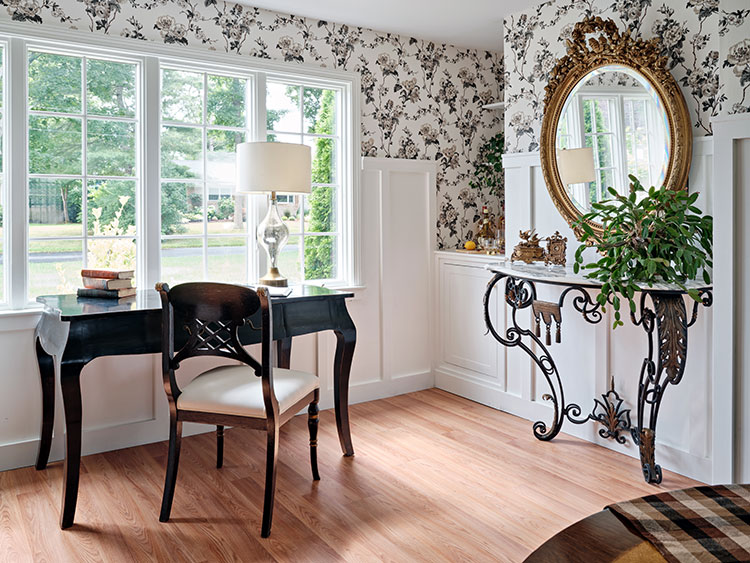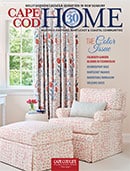
Colorific 101
Cape Cod Home / Spring 2025 / Home, Garden & Design
Writer: Julie Craven Wagner / Photographer: Dan Cutrona
Colorific 101

Cape Cod Home / Spring 2025 / Home, Garden & Design
Writer: Julie Craven Wagner / Photographer: Dan Cutrona
Interior designer Laurie Gorelick executes a master class in using color as she transforms a Barnstable Bungalow into her new home.
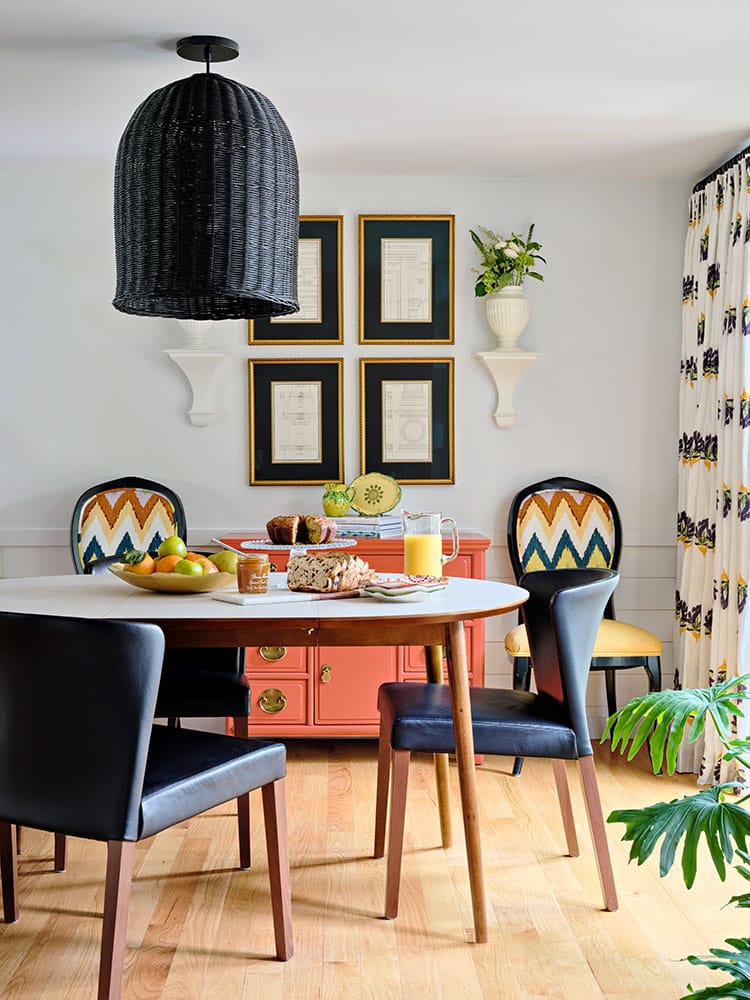
When interior designer Laurie Gorelick, principal of Cape Cod-based Laurie Gorelick Interiors, decided to sell and move from a 10-room house in South Natick, she and her husband downsized considerably. “We moved into a small rental,” she recalls, “and only kept what would work in the rental, and some sentimental items I couldn’t part with.”
This move marked a new chapter for the business—which is celebrating its 25th anniversary this year—as the decision to live full-time on the Cape also translated to interior design jobs that are focused on the surrounding area, with more projects near to home. Gorelick is a pro at furnishing a house from top to bottom, but what sets apart her approach is that she is an advocate for keeping the old things you love. Her own home illustrates how deliberately keeping those things that are meaningful; items that are a part of your past, and affording them a starring role in your future, can offer a deeply foundational connection to your home as they inspire a layered and thoughtful design.
“When we went house-hunting on Cape Cod, I looked for a home in which our furnishings would work,” Gorelick explains. “With the exception of the guest bedroom, we re-purposed all of the furnishings from our original home and rental.” The new house had been fully updated two years before as a flipped investment, so Gorelick didn’t have to attend to the bones, just the hide, and as she says, “I just had to ‘zhuzh up’ what didn’t work for me. That wasn’t at all difficult for me—I’m confident in my style preferences and I knew how I wanted the home to reflect them.”
During the construction two years before, the builder had addressed updating the kitchen and bathrooms, and had opened the living area to maximize the flow between the living, dining and kitchen areas, thereby making the modest home acceptable to Gorelick and her husband. “I felt I could live with the way things had been done and only change what bothered me and decorate the rest.”
Although Gorelick specializes in new builds and renovations, for her own home most of the decisions she made were more decorative than architectural. In the bathrooms, she replaced the builder-grade countertops, sinks, faucets, mirrors and lighting, and added wallpaper. In the living area she instantly gave the home a sense of history as well as a sense of place by replacing faux wainscoting with shiplap. The traditional colonial fireplace mantle was as she states, “…out-of-scale with the proportions of the house and didn’t mesh with the vision I had for the space. I replaced it with tile I had previously discovered and fallen in love with. The final touch was to top it with a reclaimed wood beam.”
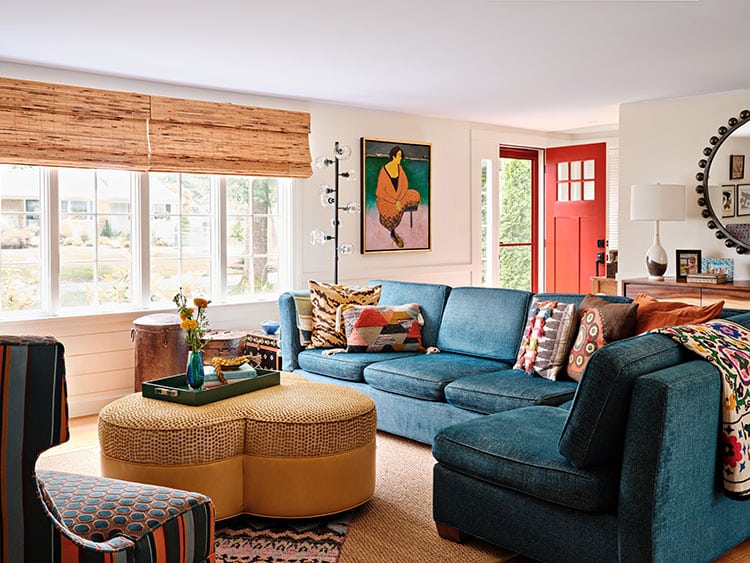
For the intimate space of the dining room where Gorelick looks forward to extended evenings of conversation and sustenance, she says, “I knew when house-hunting that I wanted a dining room. I’m sentimentally attached to my dining room furniture—it’s from my childhood home and includes my grandmother’s china cabinet. The house had a room that the previous owner had used as a rec room; I designated it as my dining room and ‘zhuzhed’ it by adding a wainscot of board and batten and wallpaper above.”
In each of the rooms, Gorelick indulged her client (herself) in an even saturation of color making the spaces cohesively connect. Use of texture and patterns keeps the rooms from feeling weighted down with the richer hues. Gorelick says the color palette for the living room was drawn from a painting she bought years ago at High Point Market in North Carolina. The piece, with its teal, lavender, marigold and terracotta tones, now stands majestically over the warm and inviting space, “Subconsciously, these colors became the palette for the living area. Yet I didn’t realize it until after the process of choosing fabrics and accents!” she says with surprise.
“My signature is mixing color and pattern in a playful way. I also like mixing old and new. I’m a proponent of sustainability,” says the LEED certified designer. “I’d rather re-purpose than buy new, even if it means spending more.” To that end, many of the furnishings in the house were pieces she had already owned and had re-upholstered or refinished to give them a fresh new life in her new home. While color, pattern and texture ground the space throughout Gorelick’s home, it is the unique and interesting choice and application of the accessories and accents that give this space a personality.
“I like accessories to further the story the design is telling, short of becoming cliché or kitschy,” she explains. “For example, I don’t like when coastal homes are drenched in nautical motifs. Although my home is on Cape Cod, we live in it year-round. I didn’t want it to be purely coastal. I have accessories that nod to that genre when appropriate—like the bathroom that has the Fornasetti fish wallpaper. But mostly, I accessorize with objects that have meaning to me—things passed down, things I’ve collected on travels and the like.”
Gorelick says the overall design for the project is rooted in the many chapters of her life. “The vision I had for the project came from the things I already had and wanted to use, as well as furnishings I had been accumulating for ‘someday.’ For example, most of the rugs in the house I had purchased on a trip to Turkey in 2021—before I even knew how I would use them. I also often take screenshots of products I like and create galleries, not only for myself but for my clients. That’s how the guest room developed—from pictures I snapped of the wallpaper and the bed which gave me the look and feel that served as the foundation for the layers of detail that got added.”
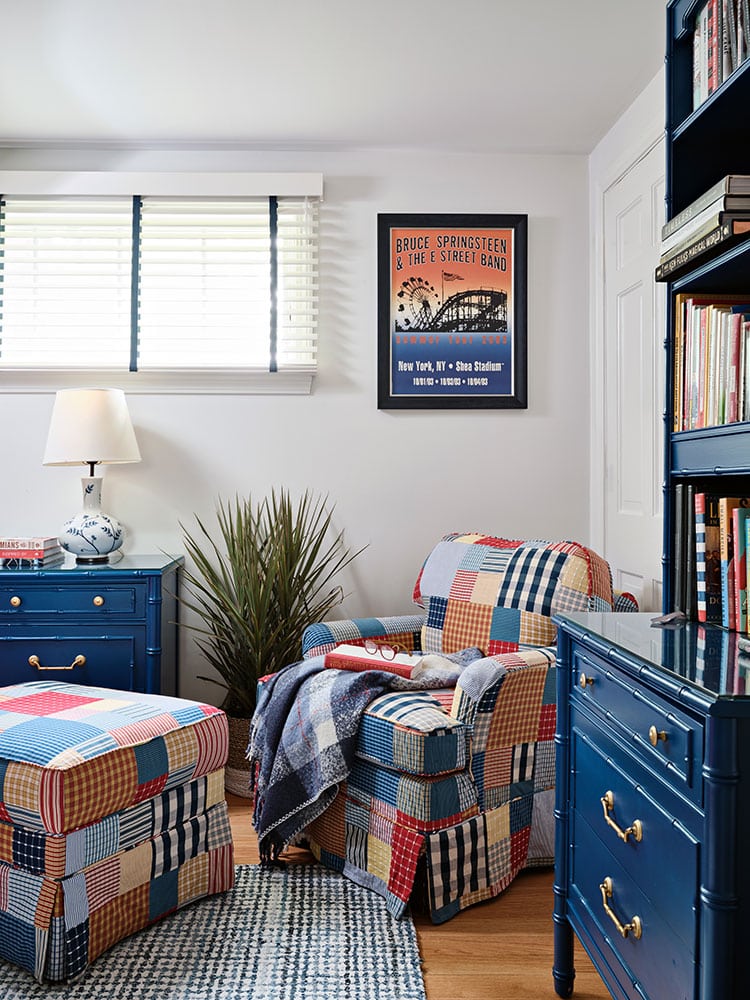
As with most recipes for perfection, an intuition for what to add and what to include with restraint, results in memorable and exceptional outcomes. Such is the case with Gorelick’s understanding of how to successfully mix patterns. “Mixing pattern requires balance,” she advises. “I take into account the scale, rhythm, color and texture of adjacent furnishings. Typically, I use a motif to unite and harmonize what others may consider competing patterns. For example, in my living area, polka dots and zig-zags are repetitive elements that unite the rugs, tiles and textures in the room. This gives the patterns a reason to be part of the overall scheme. It is the relationship to something else that endorses it; and when it is done successfully, it is a very subliminal understanding.”
These tenets of design are what define Gorelick’s ability to apply the term “Colorific” as a definition of her design sensibilities. “I coined the term ‘Colorific’ around 2010 as a way to define my design niche. ‘Colorific’ embodied my style—then and now—because the salient feature of my designs is the mix and vibrancy of color I use.” While Gorelick acknowledges her use of color as a deliberate tool in her design toolbox, her wide variety of projects exemplify a keen understanding of the entire color wheel. In her own home, the choice of Gorelick’s colors reflect the depth of collective history her possessions have accumulated on their journey through a life well-lived. For other clients, the hues, shades and tones that speak directly to their lives are the cues she employs to create personally fulfilling environments for them. “With clients, I take color cues from them—after all, they will live in the house; I won’t. But I will intervene and provide professional guidance if their color predilections aren’t complementary to a space.”
This home is a modest one, with three bedrooms, two baths and a one car garage. And Gorelick says it fits perfectly for herself and her husband for the time being. “As our family expands—married children and grandchildren—we can create options, either by adding a second story or a wing.” She also says the proximity of the home has the best of two worlds. “We live in a neighborhood of similar homes, and I like not being in a seasonal neighborhood because I enjoy having neighbors who live here year-round like us. What works is its proximity to Boston. What benefits us is we are only three miles from the beach,” she says with a smile.
It took about nine months for Gorelick and her team to complete this personal project and says there are still some things on the design board—window treatments in the dining room and re-landscaping the back yard—but, all in all, her client is very pleased with the outcome.
“The personality of the home is everything I am: nostalgic, sentimental, bohemian, and global,” she confirms. Kudos to Laurie Gorelick Interiors, another successful project and another happy homeowner. The 25th year of Laurie Gorelick Interiors continues to be “colorific”—and centered around living and working on Cape Cod—now that is something worth celebrating!
Julie Craven Wagner is the editor of Cape Cod HOME.

